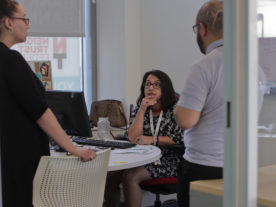
A reconstruction of the Governor’s Palace in Williamsburg, Virginia, once the official residence of the Royal Governors of the Colony of Virginia.
America’s past is revisited every day in a small town that was once the capital of Virginia, Britain’s largest, richest and most heavily populated outpost in the New World.
One of the first things you notice about Colonial Williamsburg is how picture-perfect it appears. The streets are tidy and the Georgian-inspired historic buildings are charming and well kept, exhibiting none of the shabbiness that likely existed in the 18th Century.
The other thing that strikes you is the clothes. Even in the sweltering Virginia summer sun, the colonial city’s “residents” – who are actually paid employees called interpreters – are in full period costume, which often entails long sleeves and several layers of fabric.

Colonial Williamsburg “interpreters”, paid attendants who adopt the clothing and deportment of the first Americans, are trained to interact with the public as part of a living museum.
This careful recreation of an earlier time, a masterful blending of fake and real, has been called the world’s largest living history museum.
“People really feel as if they are interacting with the past on a personal level,” said Cathy Hellier, a historian who helps train the interpreters. “It helps them to immerse themselves more in historical events. We’re hoping this will spark their interest in history.”
About 1.8 million people visit the town each year where they learn about Colonial life in the years leading up to the American Revolution, when the colonies won their independence from England.
Williamsburg was the thriving capital of Virginia for 81 years – from 1699 until 1780 – until Thomas Jefferson pushed to move the seat of state government to the more defensible and centrally located city of Richmond.
For 150 years after that, Williamsburg – home to the prestigious College of William and Mary – was best-known as a college town. Then, in 1926, the local church rector shared his idea of preserving the city’s historic buildings with philanthropist John D. Rockefeller Jr., who went on to finance the city’s restoration.
Today, the historic area of Williamsburg covers 301 acres; 88 of its buildings are original structures from the 1700s, while other houses and shops were reconstructed on their original foundations.

Costumed interpreters practice ancient crafts, such as blacksmithing, in much the same way they were practiced in 1700s America.
America’s founding fathers, such as George Washington, Thomas Jefferson and Patrick Henry, spent time here. Washington, who went on to become the nation’s first president, was godfather to 14 children baptized at the local Bruton Parish Church, which has held continuous services every Sunday since 1715.
“A lot of the 18th Century town survives unaltered, with visually engaging architecture and landscape,” said Ed Chappell, director of architectural and archaeological research at the Colonial Williamsburg Foundation. “You’ve got a real concentration of original buildings in a town laid out in a very formal way…and combine that with the history of what life was like.”
Visitors get a feel for the colonial lifestyle by watching the costumed interpreters practice ancient crafts, such as blacksmithing and brickmaking, in much the same way they were practiced in 1700s America. People can stop by the apothecary to find out which medicines were used in colonial times or they can check out the milliner for fashionable accessories of the day.
The recreated city has a quaint Disneyland-like feel to it, but be careful about calling Colonial Williamsburg an idealized version of American history.
“I take issue with the idea this is a sanitary version of history,” said Hellier. “We talk about a lot of very difficult things but we talk about them in ways that you might in a college classroom.”
Those difficult subjects include the treatment of Native Americans, women and slavery – Williamsburg even held a mock slave auction several years back.
The overriding theme of the Colonial Williamsburg story emphasizes the American principles of liberty and equality. Visitors can meet and talk to costumed workers who portray America’s founding fathers. The program seeks to remind visitors of the values that were integral to the founding of America.
“They should come away with the idea that our road to a republican form of government wasn’t easy,” said Hellier. “That participation is important and that they are encouraged to participate now in their own communities.”






















It’s a original idea to built a town like this. It reminds us to remember the history of the country in such a changing world. The experience of visiting the town could spark the interest of history. Moreover, it’s also a good way to develop the economy of the area by attracting the touristes.
so peaceful to see, I love it
It is meaningful . We live in modern life and we feel tired of what is happening. We need such place to remember our history and find peace in our life.